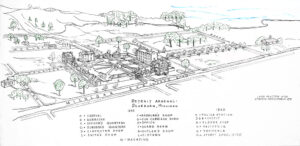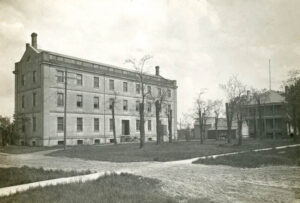
Dearborn Arsenal, Michigan.
The original Detroit Arsenal was established in 1817 in Michigan Territory along the banks of the Detroit River. The Federal artillery arsenal was built to support American troops during the Indian Wars in the “Old Northwest Territory” and served as an Army depot for repairing guns and storing gunpowder and ammunition. The inventory included small brass cannons, powder horns, howitzers, and horse harnesses.
By the 1830s, Detroit’s rapid growth necessitated that the United States military relocate the Detroit Arsenal, fearing that the stored explosives would endanger the city’s population. The U.S. Congress authorized the construction of a new arsenal. In July 1832, a site for the new Arsenal was selected west of Detroit in present-day Dearborn, Michigan. The 1,600-acre site was located near the Rouge River on the strategically important “Chicago Road” (now Michigan Avenue), which linked Detroit to Chicago, Illinois.
In July 1833, work began on the “Detroit Arsenal at Dearbornville,” which was comprised of eleven buildings. Bricks were made locally in Dearbornville, which had rich clay deposits and a burgeoning brick industry. Lumber was prepared in Detroit and shipped up the Rouge River to a specially constructed dock, and slate for the roofs was imported from New York.
Completed in 1837, it was under the command of Colonel Joshua Howard, who proposed naming the surrounding area after Major General Henry Dearborn, a New Hampshire physician and hero of the American Revolution.
The 360-foot square compound had a large parade ground surrounded by a ten-foot-high brick wall, gates, and a 75-man garrison.
A one-story powder magazine with four-foot thick walls stored gunpowder and explosive ammunition 300 yards to the east of the Arsenal. Below the magazine, on the Rouge River, Thompson’s dock was used during high water to bring heavy loads to the magazine and Arsenal.
Surrounding the Arsenal Installation was the United States Military Reserve, which comprised vast amounts of land containing lumber, grasslands, and water. The trees were used to build the Arsenal, gun carriages, ships, and any other military needs. To the north of the Arsenal on the flood plain of the Rouge River were the stables, barns, and pasture. This northern area covered Ford Field and a little beyond.

Dearbornville Arsenal Map.
The arsenal’s buildings included:
- The Armory was the largest of the buildings and was used as both a storehouse and a social center.
- Sutler’s Shop, where tobacco and personal articles were sold to the soldiers.
- Guard House.
- Enlisted Men’s Barracks.
- Surgeon’s Quarters.
- Carpenter Shop, which was converted into a chapel in about 1865.
- Smith’s Shop.
- Saddler’s Shop, where equipment for horses was made and repaired.
- Gun Carriage Shed.
- Arsenal Office.
- Commandant’s Quarters.
- The powder magazine outside the walled square.
The Arsenal remained active through the Civil War until 1875 when it was closed. It was sold to private citizens in 1877 and served the community in many ways. Before becoming a part of the Museum, the Commandant’s Quarters was used as a police station, a kindergarten, and a village hall. The Arsenal’s Armory was converted into a clothing factory known as Arna Mills until it was destroyed in a fire in 1910. The Second Officers’ Quarters was replaced with Adams Junior High and the Salisbury School Training Center. Finally, the Smith’s and Carpenter’s shops were converted into parts of Dearborn’s early auto manufacturing industry.

Barracks at Dearborn Arsenal.
Four of the original buildings still stand. The Dearborn Historical Museum owns and operates the 1833 Commandant’s Quarters, restored in 1959 and located at 21950 Michigan Avenue. Built in 1834, it is the oldest building in Dearborn, still located on its original site. It was listed on the National Register of Historic Places in 1970. The 1838 powder magazine, located at 915 Brady Street, was converted to the McFadden-Ross House in 1893. Two other remaining structures now in private ownership are the 1835 Sutler’s Shop, located at Monroe Street and Garrison Street, and the 1836 Gun Carriage Shop, located on Monroe Street.
